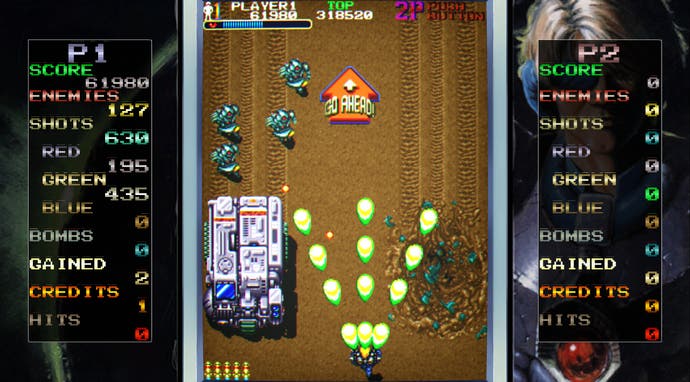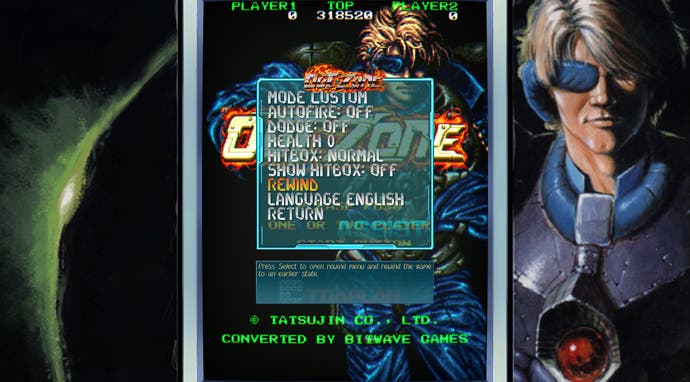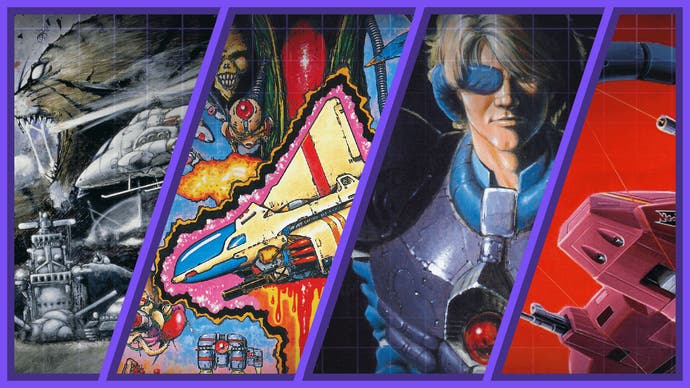Toaplan Arcade Shoot 'Em Up Collection Vol.1 review - shooting icons from another era
Highway to hell.
Toaplan's ten years making games left a tremendous legacy. Following a run of defining 2D shooters, the team ushered in the bullet hell era with 1993's triumphant Batsugun. After Toaplan closed its doors for the last time, former staff would go on to found or take senior positions at many of the shooting game genre's most important studios, such as Takumi, Gazelle, Raizing/Eighting, and the mighty Cave.
Despite those contributions, Toaplan's most famed creation is one they'd likely be none too proud of. The infamous mistranslation 'all your base are belong to us' in the European Mega Drive port of their game Zero Wing has transcended the studio, genre, and even video game medium to become a touchpoint of popular culture.
In recent years, though, a handful of the studio's games have returned, with developer-publisher M2 already porting a handful of Toaplan shooters as part of its consistently impressive 'ShotTriggers' series. Now retro specialist Bitwave Games has joined in, bringing PC owners Toaplan Arcade Shoot 'Em Up Collection Vol.1.
The collection here explores a four year period from the Japanese studio's middle history, capturing a time when Toaplan's team were exploring the fundamentals of what would later become bullet hell. That means you won't find dense bullet clouds or highly complex scoring systems here. Instead, you get to trace how, between 1987 and 1990, Toaplan's developers started to move away from the convention of more traditional shooters, and push the form into more energetic new places.
Delivered as a Steam bundle - and available as single games without the saving of the full collection - the Bitwave's debut Toaplan volume contains the unrelenting military shoot-'em-up Twin Cobra, the never-before-ported run 'n' gun-shooter hybrid Out Zone, the gorgeously realised classic that is Truxton, and the MEME-spawning horizontal scroller Zero Wing.

At a fundamental level, the ports are strong, bearing comparison with the speed and performance of the arcade originals. Running Out Zone on my treasured arcade PCB alongside Bitwave's digital version, you'd have to be fairly picky to notice a meaningful difference. The very best players out there to whom a second is enough time for all kinds of strategic play? Perhaps they'd feel tiny shifts more than other of players. But based on the available hardware, these are enjoyable ports, except for some peculiarities around the placement of some audio and sprite elements.
And the spread of games? Each brings plenty to adore.
Truxton's sci-fi vertical bristles with quality, with the original team clearly putting a tremendous amount of attention and craft in. It plays lively and dramatic, with every credit feeling like its own distinct ride. The pixel art here is especially glorious, and is brought to life by mesmerising vehicle and environment design, an abundance of tonal personality, and a dazzling display of what was possible with visual techniques of the time such as parallax scrolling. In fact, so rich is Truxton's production quality, it's hard to believe it came out as early as 1988. It really isn't bullet hell, but to play Truxton is to realise just how much influence it had over the presentation and playstyle of later genre works by Cave and its contemporaries. It's also a fairly challenging entity, though so fun to play that even when it repeatedly sends you back to the game over screen, you'll still likely have a happy grin on your face.

Zero Wing, meanwhile, was very likely informed by the success enjoyed by the arcade icons that are R-Type and Gradius. With the horizontal scrolling and sometimes claustrophobic level design, it's certainly informed by the convention set by previous 'horis', but there's enough personality and pace for it to feel much more than derivative. Zero Wing is likely closest to R-Type, and yet it moves and plays with the energy more typical of later vertically scrolling 2D shooters. The game started out with the intention that it would remain an internal project on which new staff could cut their teeth and learn the Toaplan way. It's a little long - yes, eight stages can start to feel like a grind in this genre - but it's so fun and dynamic to play, it's easy to forgive those modest faults.
Then there is 1987's Twin Cobra. It's the oldest game in this volume, and certainly the most conventional. Twin Cobra picks up on the hard military fetishism made famous in the genre by Capcom's hugely popular 1942, but ups the speed and bullet count just a little. To be frank, it hasn't aged quite so well as its compilation mates, and it remains furiously unforgiving. It's not that Twin Cobra is a bad game, or anything of the like. In tone and design and spirit it just feels rather more familiar. There were dozens of shooters that focussed on tanks and jet fighters and heavy bombers in this era, and Twin Cobra does at least bring a shade more energy if you want to get nostalgic about 80s military shooters.

The highlight, though, must be Out Zone. In breaking a scattering of the rules that make up the strict shmup design template, this brilliant creation delivers something really special. Putting you in the boots of a cyborg soldier, Out Zone is as much a run 'n' gun as a 2D shooter. It scrolls vertically, but the scrolling stops if you do. With some weapons there is multidirectional shooting, and there are plenty of hazards on the ground such as pits to tumble into. The strategy of play comes in matching ideal weapon behaviour with the immediate surroundings. You might want that multidirectional shooter when enemies come from behind in maze-like sections, or a fixed forward spread shot when you need to weave round obstacles while keeping the arsenal facing up screen. There's also an energy conservation mechanic that keeps you on your toes and pushing forward, for fear of running out of the required power to proceed.
Out Zone brings a bounty of energy and personality, as well as presentation to match most of what Truxton delivers. And having never been officially released outside of arcades before, it really increases the appeal of this package.

Now, the arrival of most retro compilations of this ilk inevitably inspires a chorus of voices to highlight emulation and options like a Raspberry Pi. Which brings us to the additional features Toaplan Arcade Shoot 'Em Up Collection Vol.1 piles on top of the games themselves. Each shooter gets online leaderboards, tweakable game and display settings, and a number of 'assists' such as hitbox reduction or highlighting. There's even a rewind button for those unburdened by the self imposed rules that come with spending too long in arcades.
While the menus can be a little cumbersome - and reassigning buttons for sticks somewhat bewildering - Toaplan Arcade Shoot 'Em Up Collection Vol.1 ultimately delivers four great, distinct shooters with all the essential modernisation and quality of life features now expected. Or three brilliant shooters and one that falls a little behind with age.
The thing is, the standard set by M2 has now left shooting game players with rather high standards. Beyond a game's own difficulty settings, Bitwave's effort does include 'normal' and 'hard' variants. But there are no thoroughly reinvented 'arranges' as seen with M2's ShotTriggers series, and the scanline, data display and related functions are a little basic. In other words, it's not quite at the level of M2's astoundingly high-quality work when it comes to modernisation.

And yet Bitwave has capably brought Western gamers four important, sometimes overlooked gems that play a pivotal role in arcade history. The capacity for fun and thrills within is immense, with only one of the games feeling a shade tired by the passage of time. A single release containing all the games and some of the context and history that connects them would have been considerably more beguiling than a bundle, but the four titles do work well together as a cohesive whole.
All these games are belong to you? Everyone should try Truxton and Out Zone. And if you have any interest in the history of arcade gaming or 2D shooters, this bundle does much to capture the journey the 2D shooter genre took from its minimalist origins to the maximalist excess of true bullet hell; a chapter of game design too often overlooked.


